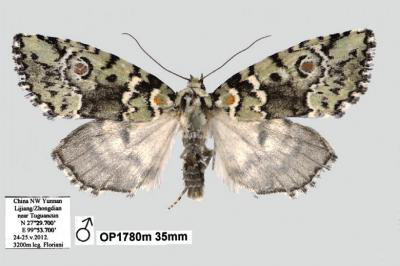A new species of moth (Stenoloba solaris) was discovered in the Yunnan province of China, a new addition to the nascent genus of moth, Stenoloba. The discovery was published in the open access journal ZooKeys.
The moth is colloquially known as the “sun moth” because of the intricate pattern that covers its upper wings and resembles the rising sun. Color, wing pattern, and genital characteristics distinguish Stenoloba solaris from other species of Stenoloba. Discoveries of species within this genus have blossomed in recent decades with only 35,000 species of an estimated 100,000 have been documented. In contrast, the number of mammals worldwide is currently less than 6,000.
Researchers collected a single male specimen of the sun moth in an area of the Baima Xue mountain range that researcher Oleg Pekarsky describes as a “wide river valley…dominated by various conifer trees, bushes and rhododendron.” The Baima Xue mountain range is a Yunnan protected area within a UNESCO World Heritage sight that is known for its biodiversity and healthy ecology. Because of this, the sun moth suffers little from human impact on the environment. Other than its habitat, little is known about the sun moth in regards to population, diet, range, and predation.

Photo credit: Oleg Pekarsky, collected sun moth specimen.

Photo credit: Oleg Pekarsky, habitat of the sun moth in the Baima Xue mountain range
CITATION: Pekarsky O, Saldaitis A (2013) A new species of Stenoloba Staudinger, 1892 from China (Lepidoptera, Noctuidae, Bryophilinae). ZooKeys 310: 1, doi: 10.3897/zookeys.310.5125
Related articles
Common moth can hear higher frequencies than any other animal on Earth
(05/09/2013) A common little moth turns out to have the best ears in the animal kingdom. According to a new study in Biology Letters, the greater wax moth (Galleria mellonella) is capable of hearing frequencies up to 300,000 hertz (300kHz), which is 15 times the frequency humans can hear at their prime, around 20 kHz.
Unidentified poodle moth takes Internet by storm

(08/29/2012) A white moth from Venezuela that bears a striking resemblance to a poodle has become an Internet sensation, after cryptozoologist Karl Shuker posted about the bizarre-looking species on his blog. Photographed in 2009 in Venezulea’s Canaima National Park in the Gran Sabana region by zoologist Arthur Anker from Kyrgyzstan, the white, cuddly-looking moth with massive black eyes has yet to be identified and could be a species still unknown to science.